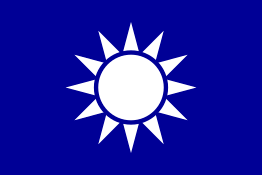First United Front

.svg.png)
The First United Front, also known as the KMT–CPC Alliance, of the Kuomintang (KMT) and the Communist Party of China (CPC), was formed in 1923 as an alliance to end warlordism in China. Together they formed the National Revolutionary Army and set out in 1926 on the Northern Expedition. The CPC joined the KMT as individuals, making use of KMT's superiority in numbers to help spread communism. The KMT, on the other hand, wanted to control the communists from within. Both parties had their own aims and the Front was unsustainable. In 1927 Nationalist Field Marshal (Generalissimo) Chiang Kai-shek purged the Communists from the Front while the Northern Expedition was still half-complete. This initiated a civil war between the two parties that lasted until the Second United Front was formed in 1936 to prepare for the coming Second Sino-Japanese War.
The resurrection of Kuomintang
During the time of warlords, Sun Yat-sen kept the idea of a united Chinese republic alive. His goal was to establish a rival government in Guangzhou, southern China, and go from there to fight against the warlords in the North and their Beiyang government. Upon his return from exile in 1917, Sun revived his banned nationalist party, the Kuomintang, but this time he gave it the new name, the Kuomintang of China. His plan was that after defeating the warlords the party would guide China until the country would be ready to move to democracy.
The rival government led by Sun, however, was at a disadvantage against the warlords from a military point of view. Despite his requests for aid from the West, badly needed financial and arms support never arrived in the country. In the 1920s the Kuomintang eventually received help from a surprising source: the Russian Bolsheviks. Material aid from Russia was good enough for Sun, who had previously shown flexibility when the question was about the promotion of the republic. He had neither sympathy towards Marxism nor did he see communism as a solution to China's problems. In Sun's view, China was not of the rich and the poor; rather, it was the country of the poor and the poorer. The guidelines of the Kuomintang were based on Sun's "Three Principles of the People": nationalism, democracy and the people's livelihood (socialism).
The Kuomintang gradually became a powerful and disciplined party under Russian guidance. The decisive factor was Bolshevik assistance to the Kuomintang in the formation of its own army, the National Revolutionary Army. In order to train the army the Whampoa Military Academy was established near Guangzhou. As its director, Sun appointed his loyal supporter Chiang Kai-shek. Financially the Whampoa Military Academy operated with the support of the Soviet Union. The quality of education was guaranteed by regularly visiting Russian officers. Many of the leaders of both the Kuomintang and the Chinese Communist Party graduated from the academy—the chief commander of the People's Liberation Army, Lin Biao, graduated from Whampoa as did Zhou Enlai, who later became prime minister of Communist China.
Together against the warlords and imperialists
The Soviet Union had its own interests in supporting the Kuomintang. The Bolsheviks, in exchange for their help, demanded that the Kuomintang form an alliance with the Chinese communists. Moscow was not convinced that the communist party alone would be able to complete the revolution in the country, which was thought to be ready for communism right after the bourgeoisie destroyed the old Chinese dynastic system. China's newly founded communist party had only a few hundred members at the beginning of the 1920s, whereas the Kuomintang had over 50,000. The idea was that the communists would gain broader support by joining the common front with the nationalists, after which they would eventually take over from the Kuomintang. At the request of the Russians, the Chinese communists—among them Mao Zedong—became members of the Kuomintang, and thus the first coalition of the two parties was born.
With the help of the Soviet Union the Kuomintang did succeed in gaining more support, and with renewed vehemence it continued to vigorously pursue its goal—the unification of the republic. Securing its grip on southern China, the Kuomintang was ready to unite the country by launching a military campaign against the North. The coalition with the communists, however, was a forced union, held together only by their common enemies: the warlords and imperialism. After the death of Sun Yat-Sen in 1925 cooperation began to weaken, and the right wing of the Kuomintang soon put an end to the brotherhood with the Soviet Union and the Chinese communists.
Fall
The First United Front was formed so the KMT and the CCP could join together to strengthen China. The initial aim was to help defeat the warlord threat (through the Northern Expedition of 1926–28), but both parties actually had ulterior motives with this alliance. The CCP formed it mainly so it could spread communism through the KMT's numbers, while Chiang's aim was to help control the Communist party from the inside. Having said that, he was also the main reason the relationship fell apart, due to his desire to control the Communist party, ultimately leading to the disintegration of the United Front. After purging the Communists and Soviet advisors from Whampoa and his Nationalist army during the 1926 "Canton Coup", Chiang went on to kill a large number of Communist forces in mid-1927, which is aptly called the Shanghai massacre. It was considered a purge initiated by Chiang, which occurred about halfway through the Northern Expedition. Chiang wanted to control all of China, and controlling the Communist party would make this a lot easier for him. His purge ultimately ruined this union, however, and resulted in a civil war, which was postponed when the two sides formed the Second United Front to combat the Japanese in the Second Sino-Japanese War.